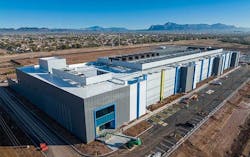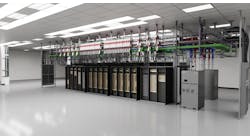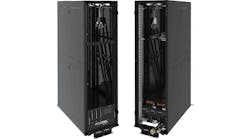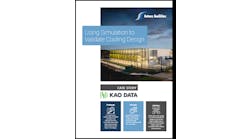ASHBURN, Va. – “Land and expand” is a term commonly used to describe data center projects that begin with a modest footprint and grow along with the underlying business.
NTT Global Data Centers Americas has spent the past two years entering new markets, opening data center campuses in Hillsboro, Chicago, Santa Clara and Phoenix. The company is now shifting into “expand” mode as it adds data centers on most of its seven U.S. campuses.
“We’re building in every market,” said Douglas Adams, President and CEO of NTT Global Data Centers Americas. “We are maximizing all of our existing sites. One of the things our client base has told us that they appreciate how we build ahead in our markets.”
Having inventory available to sell is important in any business. But that’s no small matter in data centers, a capital-intensive process that requires land, permitting, design and construction before there is a usable product. Having capacity can provide an advantage, especially as customers seek accelerated delivery timelines to meet demand for cloud services.
“It’s a great time to be in the data center industry,” said Adams. “We’re seeing an exponential shift in adoption of cloud computing, and it doesn’t seem to be slowing. In September, we started to see a pretty big uptick for us, and it’s accelerating.”
Executing on a Five-Year Plan
The building boom is the realization of a vision that has been percolating since 2013, when giant Japanese telecom company NTT acquired a majority stake in U.S. data center specialist RagingWire. Adams was already seeing the IT landscape being transformed by huge global cloud platforms. The capital strength of NTT allowed the RagingWire team to dream bigger.
“In the next five years, we will have a data center presence in the top six U.S. markets,” Adams told Data Center Frontier back in 2016.
At the time, the company had four facilities – two in Sacramento and two in Ashburn. In 2017 it opened a campus in the Dallas market, launching a first building, with room for four more on the 40-acre campus. In 2018 it added data centers in Ashburn on a large new campus.
Then came hypergrowth mode, which kicked off in 2020 when RagingWire rebranded as NTT Global Data Centers Americas, and continued in 2021 as the company opened three new campuses in Hillsboro and Chicago – in the same week in February – followed by Santa Clara in June.
In March the company opened its newest campus near Phoenix, completing the first phase of its Ph1 data center in Mesa, a suburb of Phoenix.
“We’re seeing the evolution of this five-year plan we put together,” said Adams.
A Campus-Driven Strategy for Customer Growth
With the new campuses landed, the next stage is the “expand” part. Each campus is designed for multiple data centers, which allows customers who want contiguous space to easily add capacity in adjacent data halls or buildings.
It’s not possible to do this in every market. NTT has launched with a single 16 MW data center in Santa Clara, a supply-constrained market with limited land available where most new data centers are “knock-down” projects that raze and replace an existing building. In Chicago, the company has 19 acres in Itasca, enough for two 36-megawatt buildings.
But in markets where and is more plentiful, NTT Global Data Centers has procured large propeties that support expansion over time:
- Hillsboro, Oregon: A 47-acre campus will support 5 buildings, SF and 126 MW of capacity.
- Phoenix: A 102-acre campus in Mesa with room for 7 buildings spanning 1.5 million SF and 240 MW of data center capacity.
- Ashburn: The newest campus supports 7 data centers and 224 MWs of capacity.
- Dallas: 42 acres in Garland, with room for 5 buildings and 1 million SF and at least 80 MWs of capacity.
“I would see us continuing to invest in markets where we have land and utility power,” said Don Schopp, Vice President of Strategic Growth and Channel Sales at NTT Global Data Centers Americas.
The company’s approach to Ashburn provides an example. In its first two stand-alone facilities, RagingWire built its data center infrastructure inside existing powered shells, with its vaults (data halls) averaging 2 megawatts in capacity. In 2018 it launched its primary campus in Data Center Alley, shifting to greenfield construction, customized from the ground up to support the company’s vision for Internet-scale campuses.
The first building, VA3, is a 16 MW data center featuring a mix of vault designs from 2 megawatts to 6 megawatts of power capacity, as well as a large room for multi-tenant retail colocation.
VA4 and VA5 are 32-megawatt buildings with expanded and standardized vaults, and VA6 will feature NTT’s new 36-megawatt design – two floors, with three 6-megawatt data halls on each floor.
On a multi-building campus, it’s critical to know when to begin construction on the next phase. Customers want visibility into the timing for future capacity. Developers are careful about speculative building, but the high levels of pre-leasing seen in recent months helps manage that reduce risk.
“We are pre-selling and building as fast as we can,” said Adams. “Part of our success is that we’ve made that commitment (to build more capacity) when others have not.”
A Growth Story With a Long Horizon
The company’s designs have evolved along with industry trends. As RagingWire, it once focused on ultra-redundant “2N+” designs for colocation customers. It then pivoted to hyperscale customers, retooling its construction operations along the way to deliver capacity more rapidly.
“We need to move at the pace that deals move, and our customers move,” said Schopp. “The demand and the need for capacity is huge, and the sophisticated end clients have gotten extraordinarily good (at procuring data centers).”
The network meet-me room inside the NTT Global Data Centers Americas facility in Hillsboro, Oregon. (Photo: NTT)
NTT Global Data Centers is now the world’s third-largest data center company, integrating multiple brands like e-shelter, Gyron, Netmagic, NTT Communications Nexcenter, RagingWire and others that formerly operated under the NTT Communications brand. Its global footprint includes 102 data center properties ranging from Chennai to Johannesburg to Sacramento, along with the backing of NTT, which has more than 320,000 employees and annual revenue of about $21.8 billion.
The recent evolution of the data center sector places a premium on financial strength and a strong global supply chain. NTT offers both, along with access to low-cost capital, which is an important competitive factor with the recent market entry of huge global financial titans like Blackstone, KKR, Global Infrastructure Partners, Brookfield and EQT Infrastructure, among others.
“This is an insanely capital-intensive business,” said Adams. “My belief is that we’re the only data center provider at a global scale with access to interconnected data centers in all of the top markets.”
That’s a quite a change from the company’s early days in 2001, when Adams sold colocation space by the cabinet and cage from a single RagingWire data center in Sacramento.
“It has been an incredible ride,” said Adams. “I’m super excited.”






